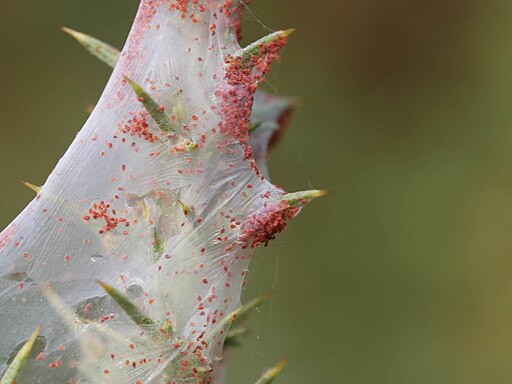Spider mites can infest more than 1,200 species of plants.
Here are the 100 of them:
- African Violet
- Begonia
- Basil
- Cactus
- Cucumber
- Dahlia
- Daisy
- Ficus
- Geranium
- Hibiscus
- Impatiens
- Lavender
- Marigold
- Mint
- Orchid
- Pepper
- Petunia
- Poinsettia
- Rose
- Sage
- Snapdragon
- Spinach
- Strawberry
- Sunflower
- Tomato
- Verbena
- Zinnia
- Fern
- Hosta
- Hydrangea
- Ivy
- Jasmine
- Kalanchoe
- Lemon Tree
- Lilac
- Lily
- Marble Queen Pothos
- Monstera
- Nerium
- Oleander
- Palm
- Parsley
- Peony
- Philodendron
- Pine
- Plumeria
- Roses
- Sago Palm
- Sedum
- Shrub Rose
- Snake Plant
- Spider Plant
- Succulent
- Tulip
- Venus Flytrap
- Wandering Jew
- Watermelon
- Wheat
- Zebra Plant
- Aloe Vera
- Bamboo
- Basil
- Bee Balm
- Bottlebrush
- Bromeliad
- Canna Lily
- Carnation
- Cherry Tree
- Chrysanthemum
- Cilantro
- Coleus
- Coral Plant
- Cotton
- Daffodil
- Dandelion
- Dill
- Eucalyptus
- Fennel
- Fuchsia
- Gardenia
- Gerbera Daisy
- Grapevine
- Hawthorn
- Honeysuckle
- Hyacinth
- Iris
- Jasmine
- Kale
- Lemon Balm
- Lemon Verbena
- Lettuce
- Lupine
- Magnolia
- Mandevilla
- Marjoram
- Milkweed
- Morning Glory
- Nasturtium
- Nectarine Tree
- Oregano
Spider mites are quite adaptable and can infest both indoor and outdoor plants.
Overview Information about Spider Mites
Spider mites are tiny arachnids that belong to the family Tetranychidae. Here are some key points about them:
Appearance
- Size: Spider mites are very small, usually less than 1 mm in length.
- Color: They come in various colors, including red, green, yellow, and brown.
- Webbing: Many species spin fine webs on the undersides of leaves, which protect them and their eggs.
Life Cycle
- Stages: The life cycle includes the egg, larva, protonymph, deutonymph, and adult stages.
- Reproduction: Females lay eggs on plant surfaces. The entire life cycle can be completed in as little as a week under optimal conditions.
Habitat
- Host Plants: Spider mites feed on over 1,200 species of plants, including ornamental plants, vegetables, fruits, and trees.
- Preferred Conditions: They thrive in hot, dry conditions and can reproduce rapidly under such circumstances.
Feeding and Damage
- Feeding Mechanism: Spider mites use piercing-sucking mouthparts to extract sap from plant cells.
- Damage Symptoms: Infested plants often show stippling (tiny yellow or white spots), yellowing, browning, and eventual leaf drop.
Step-by-Step Guide to Treat Spider Mite Infestation on Plants.
Step 1: Identify Infestation
Inspect Regularly: Examine your plants frequently, especially the undersides of leaves.
Look for Symptoms: Check for tiny moving dots, yellowing leaves, and fine webbing.
Step 2: Isolate Infested Plants
Separate Plants: Immediately move infested plants away from healthy ones to prevent the spread.
Quarantine New Plants: Keep new plants isolated for a few weeks before integrating them.
Step 3: Increase Humidity
Mist Plants: Regularly mist the leaves with water to create a less favorable environment for mites.
Humidifier: Use a humidifier in indoor settings to maintain higher humidity levels.
Step 4: Physical Removal
Water Spray: Use a strong stream of water to dislodge mites from the leaves.
Wipe Leaves: Gently wipe the leaves with a damp cloth or sponge.
Step 5: Apply Miticides
Insecticidal Soap: Spray insecticidal soap on the infested plants, making sure to cover all surfaces.
Neem Oil: Mix neem oil with water and a few drops of dish soap, then spray it on the plants.
Horticultural Oil: Use horticultural oil to smother the mites and their eggs.
Step 6: Introduce Natural Predators
Predatory Mites: Release predatory mites like Phytoseiulus persimilis to feed on the spider mites.
Ladybugs and Lacewings: Introduce ladybugs or lacewings, which are natural predators of spider mites.
Step 7: Use Homemade Remedies
Alcohol Solution: Mix rubbing alcohol with water and apply it to the leaves.
Garlic Spray: Create a garlic spray by blending garlic cloves with water and straining the mixture.
Essential Oils: Use a spray made from rosemary, peppermint, or eucalyptus oils.
Step 8: Maintain Plant Health
Proper Watering: Ensure your plants are well-watered but not overwatered.
Fertilize: Apply appropriate fertilizers to keep plants healthy and resilient.
Prune Infested Areas: Remove heavily infested leaves and dispose of them properly.
Step 9: Clean Surroundings
Sanitize Tools: Disinfect garden tools after use to prevent the spreading of mites.
Remove Debris: Clear away plant debris and fallen leaves around the plants.
Step 10: Monitor and Repeat
Regular Monitoring: Keep a close eye on your plants to catch any new infestations early.
Reapply Treatments: Repeat treatments as needed until the infestation is fully controlled.
Long-Term Prevention
Maintain Humidity: Continue to keep humidity levels up to discourage mite development.
Rotate Plants: Change the location of plants to disrupt mite habitats.
Use Resistant Varieties: Choose plant varieties that are less prone to mite infestations.
Cover Soil: Use reflective mulch or plastic covers to prevent mites from crawling up.
Introduce Air Flow: Ensure good ventilation around plants to reduce mite populations.
Inspect New Plants: Always inspect new plants thoroughly before bringing them home.
Educate Yourself: Stay informed about spider mite control and prevention strategies.
Want to Try More Spider Mite Treatment Options?
Here are 50 spider mite treatment options to help you manage and eliminate these pesky pests:
- Water Spray: Use a strong stream of water to dislodge mites from plants.
- Neem Oil: Apply neem oil as a natural insecticide.
- Insecticidal Soap: Use insecticidal soap to kill mites on contact.
- Horticultural Oil: Suffocate mites and their eggs with horticultural oil.
- Alcohol Solution: Dab leaves with a solution of rubbing alcohol and water.
- Essential Oils: Use sprays made from rosemary, peppermint, or eucalyptus oils.
- Garlic Spray: Create a garlic spray to repel mites.
- Molasses Solution: Use molasses mixed with water to deter mites.
- Liquid Seaweed: Apply liquid seaweed as a natural deterrent.
- Predatory Mites: Introduce predatory mites like Phytoseiulus persimilis.
- Ladybugs: Release ladybugs to feed on spider mites.
- Lacewings: Use lacewings as natural predators.
- Diatomaceous Earth: Sprinkle diatomaceous earth around plants to kill mites.
- Hydrogen Peroxide: Spray hydrogen peroxide on infested plants.
- Baking Soda: Use a baking soda solution to treat mites.
- Vinegar Solution: Apply a vinegar solution to affected plants.
- Cinnamon: Sprinkle cinnamon around plants to deter mites.
- Chili Pepper Spray: Use a chili pepper spray to repel mites.
- Citrus Oil Spray: Apply citrus oil spray to infested plants.
- Eucalyptus Oil: Use eucalyptus oil as a natural repellent.
- Peppermint Oil: Apply peppermint oil to deter mites.
- Rosemary Oil: Use rosemary oil as a natural insecticide.
- Thyme Oil: Apply thyme oil to infested plants.
- Oregano Oil: Use oregano oil to repel mites.
- Sage Oil: Apply sage oil to affected plants.
- Lemon Oil: Use lemon oil as a natural deterrent.
- Bay Oil: Apply bay oil to infested plants.
- Clove Oil: Use clove oil to repel mites.
- Fennel Oil: Apply fennel oil to deter mites.
- Marjoram Oil: Use marjoram oil as a natural insecticide.
- Mint Leaves: Crush mint leaves and apply to plants.
- Garlic Leaves: Crush garlic leaves and apply to infested plants.
- Onion Spray: Use an onion spray to deter mites.
- Chamomile Tea: Apply chamomile tea to affected plants.
- Compost Tea: Use compost tea to treat mites.
- Eggshell Spray: Crush eggshells and apply to plants.
- Banana Peel Spray: Use a banana peel spray to deter mites.
- Coffee Grounds: Sprinkle coffee grounds around plants.
- Corn Gluten Meal: Apply corn gluten meal to deter mites.
- Fish Emulsion: Use fish emulsion as a natural deterrent.
- Worm Castings: Apply worm castings to infested plants.
- Compost: Use compost to improve plant health and deter mites.
- Soil Amendments: Add soil amendments to improve plant health.
- Fertilizers: Use fertilizers to strengthen plants.
- Mulch: Apply mulch to retain soil moisture and reduce dust.
- Pruning: Prune infested plant parts and dispose of them.
- Sanitation: Keep the area around plants clean and free of debris.
- Air Circulation: Ensure good air circulation around plants.
- Reflective Mulch: Use reflective mulch to deter mites.
- Professional Help: Consult pest control experts if infestations persist.
Tell me only organic remedies
Harsh chemical will do more damage than good to your plants, but there are several organic remedies you can try to get rid of spider mites:
- Water Spray: Regularly spraying your plants with water can help dislodge spider mites. Use a strong stream of water to knock them off the leaves.
- Insecticidal Soap: Mix a few tablespoons of mild liquid soap with water and spray it on the affected plants. The soap will suffocate the mites1.
- Neem Oil: Neem oil is a natural pesticide that can help control spider mites. Mix neem oil with water and a few drops of dish soap, then spray it on the plants1.
- Rosemary Oil: Mix rosemary oil with water and organic liquid soap to create a spray that repels spider mites.
- Lemon Juice: Combine lemon juice with water in a spray bottle and apply it to the plants. The acidity helps deter spider mites.
- Diatomaceous Earth: Sprinkle food-grade diatomaceous earth around the base of the plants. It dehydrates and kills the mites upon contact.
- Beneficial Insects: Introducing predatory insects like ladybugs, lacewings, or predatory mites can help control spider mite populations naturally.
Remember to regularly check your plants for signs of spider mites, such as fine webbing or yellowing leaves, and treat them promptly to prevent a severe infestation.
To explore more about Spider mites, check out 50 Interesting Facts about Spider Mites.


Leave a Reply